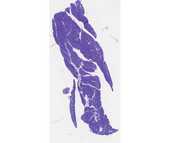Exocrine and Endocrine Pancreas
 The pancreas develops as dorsal and ventral outgrowths of the duodenum, and its two diverticula fuse during later embryonic development. The pancreas contains both exocrine and endocrine components. The exocrine component consists of purely serous acini. It is the site of production and release of digestive enzymes (in an inactive state). These are delivered through a duct system that is similar to that in the salivary glands: intercalated duct to intralobular duct to interlobular duct. A diagnostic feature of the exocrine pancreas is the presence of centro-acinar cells. These cells form the initial portion of the intercalated duct. The pale-staining nuclei of the centro-acinar cells appear in the center of an acinus (hence their name).
The pancreas develops as dorsal and ventral outgrowths of the duodenum, and its two diverticula fuse during later embryonic development. The pancreas contains both exocrine and endocrine components. The exocrine component consists of purely serous acini. It is the site of production and release of digestive enzymes (in an inactive state). These are delivered through a duct system that is similar to that in the salivary glands: intercalated duct to intralobular duct to interlobular duct. A diagnostic feature of the exocrine pancreas is the presence of centro-acinar cells. These cells form the initial portion of the intercalated duct. The pale-staining nuclei of the centro-acinar cells appear in the center of an acinus (hence their name).
For a more detailed description of the endocrine portion of the pancreas see the endocrine glands lab on page 61.
#107 Pancreas thin section, Acid fuchsin toluidine blue
In the exocrine portion of the pancreas on this slide note that the basal cytoplasm of the acinar cells is highly basophilic. Zymogen granules at the apex are very acidophilic. The cytoplasm of centro-acinar cells and duct cells is relatively unstained. This slide clearly demonstrates the duct system in the pancreas. Islets of Langerhans are clearly visible, however the classes of hormone producing cells are not distinguishable.
